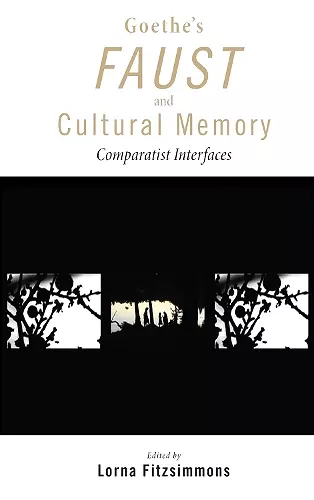Goethe's Faust and Cultural Memory
Comparatist Interfaces
Format:Hardback
Publisher:Associated University Presses
Published:17th Aug '12
Currently unavailable, our supplier has not provided us a restock date

This book is an interdisciplinary collection of essays examining Goethe’s Faust and its derivatives in European, North American, and South American cultural contexts. It takes both a canonic and archival approach to Faust in studies of adaptations, performances, appropriations, sources, and the translation of the drama contextualized within cultural environments ranging from Gnosticism to artificial intelligence. Lorna Fitzsimmons’ introduction sets this scholarship within a critical framework that draws together work on intertextuality and memory. Alan Corkhill looks at the ways in which the authority of the word is critiqued in Faust and Marlowe’s Dr. Faustus. Robert E. Norton revisits the question of Herder as Faust and the early twentieth-century context in which the claim resonated. J. M. van der Laan explores the symbolic possibilities of the mysterious Eternal-Feminine. Frederick Burwick examines Coleridge’s critique of Goethe’s Faust and his own plans for a Faustian tale on Michael Scott. Andrew Bush demonstrates how Estanislao del Campo’s poem “Fausto” retells Gounod’s opera in the sociolect of Argentine gauchos. David G. John examines complete productions of Goethe’s Faust by Peter Stein and the Goetheanum. Jörg Esleben surveys contemporary Canadian interplay with Goethe’s Faust. Susanne Ledanff discusses the significance of Goethe’s Faust for Werner Fritsch’s avant-garde “Theater of the Now.” Bruce J. MacLennan examines Faust from the perspective of a researcher in several Faustian technologies: artificial intelligence, autonomous robotics, artificial life, and artificial morphogenesis.
Of this volume's nine essays, all by leading scholars in Europe and the US, several are particularly significant. Among these are J. M. van der Laan's "The Enigmatic Eternal-Feminine," which takes the view that the mystical conclusion of Faust II is "unsatisfactory and unacceptable" (but one wonders if the essay itself does not explain the mystery by pointing to the fact that this concluding vision of salvation is a metaphor--Goethe emphasizes that what is done is done here, not in an unknowable afterlife) and Robert Norton's "Herder as Faust," which reviews the evidence that the dynamic, cynical Herder was a model for the Faust figure. David John's "The Complete Faust on Stage: Peter Stein and the Goetheanum" is an absorbing read. Stein claimed that his 2000 production of the entire Faust was "the first professional performance of the complete tragedy." Not so, according to John, who witnessed not only the 13-hour Stein production but also the Goetheanum production (18 hours over three days) in 2004. The latter production, staged every five years since 1938 in Dornach, Switzerland, likewise used professional actors. In the introduction, "Magian Mnemotechny," Fitzsimmons (California State Univ., Dominguez Hills) references numerous Goethe scholars, but only briefly the essays themselves. Summing Up: Recommended. Upper-division undergraduates and above. * Choice Reviews *
Rarely does a collected volume live up to the promise of its title as emphatically as Lorna Fitzsimmons’s Goethe’s Faust and Cultural Memory. The “comparatist interfaces” invoked by the subtitle is a phrase that so often glides meaninglessly by, but not here.... The volume ends far from where it begins, a testament to the breadth of Faust’s concerns and to the range of its significance as a cultural touchstone. The variety of approaches and fields on display, as well as the wealth of bibliographic references, makes this volume a valuable resource for any research on Faust’s radiations into the realm of cultural memory and a showcase of the power of the drama itself. * Goethe Yearbook *
ISBN: 9781611461220
Dimensions: 236mm x 157mm x 23mm
Weight: 481g
230 pages